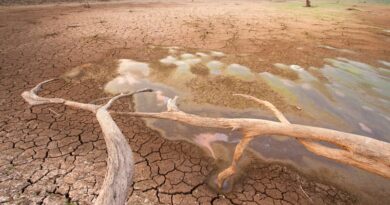What drives cataclysmic water crisis in 21st century India?

J Harsha
It is very enticing to know that India currently is in possession of 257 BCM of live storage capacity of surface water from all of its large reservoirs (Press Information Bureau, 2020). Further, there is a prognosis that this 257 BCM live storage could be extended up to a maximum of 385 BCM in the near future. If this is true, then it certainly will invoke a sense of secure water future for the nation.
But, data can delude stakeholders to believe that India is in possession of adequate quantity of water reserves for its water security – to meet the domestic water requirements of the current level of 1.31 billion population, requirements of growing food, generation of energy, requirements for industry and environment. Or it can also delude that India has adequate water resources for a secure water future i.e. to meet the requirements of projected 1.64 billion population by 2050.
Under the existing topographical feasibility and constraints, India can theoretically create a supply of 385 BCM of ultimate storage capacity out of all the present and future dams according to Garg and Hassan (2007) i.e. equivalent to the live storage of about 60 Bhakra reservoirs. Along with the renewable ground water of 432 BCM, 385 BCM of surface water is one of the key drivers of India’s economy from the present level towards $10 trillion and even more (as no water mean no economy).
It is the ability to achieve 385 BCM of ultimate storage capacity that can triple and quadruple farmer’s income as water is the key input in enhancing farm income along with credit, crop insurance and agro-investment. Ultimately, the ability to achieve 385 BCM ultimate storage capacity and sustain 257 BCM of surface water in its reservoirs is what secures India’s food, energy, the sustainable cities, environment and economic security in 21st century and beyond. But, whether the storage capacities currently projected is reliable forever? That is a key question.
Flawed useful life of reservoirs
The question arises because Indian dams and reservoirs are not getting younger anymore. In fact, Indian dams are dying or many of them must have already dead except of course they remain alive on paper forever. Scholarly evidences show that water in the reservoirs is gradually receding; being replaced by soil. Unlike the depleted ground water table that can be replenished during higher rainfall events there is no way the reservoir storage filled with sediment can be retrieved or replenished. There is no cost-effective technology that is available to desilt the reservoir completely, dispose the same and restore the live storage. In a paper published in 2003, Rohan D Souza (2003) showed that several Indian reservoirs are designed with flawed siltation rates. According to him, the siltation rate in one of independent India’s iconic Bhakra dam is 139.86% higher than originally assumed siltation rate. Similarly, the actual siltation rate observed for dams such as Hirakud, Maithan and Ghod are way way higher at 141.67%, 808.64% and 426.59% respectively. The study was conducted about 17 years ago. So, the study shows India’s design of reservoir useful life is flawed.
Another scholar Kothyari (2009) showed that the design siltation rates in reservoirs spread across many river basins of India is flawed. He compared the design siltation rates with observed values in 1970s. The results are incriminating. For example, the designed siltation rate of Nizamsagar in Godavari river basin was 29 m3 km-2 per year whereas the observed value in 1972 was found to be 634 m3 km-2 per year about 2000% increase than designed rate originally contemplated. The year of impounding of Nizamsagar is 1931. This phenomenon was observed in other reservoirs such as Tungabhadra, Panchet and Ramganga in diverse river basins.
Therefore, studies show that Indian reservoirs are designed with 1) poor knowledge of sedimentation science, and 2) flawed siltation rate and over-estimation of live storage capacity created. Studies from scholars therefore clearly show that the supplies may have already choked in several reservoirs because almost all of the higher siltation rates observed in these studies were in the decade of 1970s i.e. about 50 years back.
The threat of ageing dams
To compound the problem, Indian dams are not getting younger. For example: Krishnaraja Sagar dam and Mettur dam, two major reservoirs in water scarce and conflict ridden Cauvery river basin of Southern India were built in 1931 and 1934 respectively. As on 2020, the Krishnaraja Sagar dam is 90 years old. Similarly, the age of Mettur dam in the state of Tamil Nadu is 87 years. Other major dams in the basin such as Bhavanisagar and Amaravathy have crossed 60 years according to National Register of Large Dams (2018). There were about 368 large dams at the time of Indian independence from British colonial rule seven decades ago. The number now stands at 5264 completed large dams and another 500 ongoing large dams as per Government records.
Besides there are hundreds of thousands of medium and minor dams with useful life varying from 10 to 50 years. In all, about 1100 large dams are already aged between 50 years and more than 120 year old as on year 2020. This number is bound to increase to 2307 large dams by year 2030 and further 3709 by year 2040 and by year 2050 about 4406 large dams will be between 50 years and more than 150 years old. So, in the next 2-3 decades, about 80% of large dams in India could come close to being obsolete considering their age and flawed design of their useful life. The situation with hundreds of thousands of medium and minor dams is even more precarious as their useful life is even less than that of large dams and the data of the condition of these dams is either limited or obscured. So, the fallacious storage capacities that ignore lost storage have deluded stakeholders into believing that India is in possession of safe and sustainable water future. This is cataclysmic.
Fallout of the extinction of India’s reservoirs
Until now, India’s water crisis has been attributed to demand. Population explosion, economic growth, change in consumption pattern, urbanization have been the leading causal factors in every water policy and most of the scholarly literature for the water crisis in India. But nowhere the water policies so far have focused on the inevitable supply constraints due to flawed siltation rates and dying dams and reservoirs.
Somehow, the deceptive water reserves, flawed design siltation rates, falling storage capacities, dissipating water reserves, dying dams and extinction of reservoirs are conspicuously omitted. This is disastrous because as supply chokes, the demand-supply gap increase manifold. India will eventually be unable to find sufficient water in 21st century to feed the rising population of 1.64 billion, to grow crops, the bustling and sprawling urban agglomerates, generate energy and drive its economy. With reservoirs filled with soil instead of water, there will be no chance for India to overcome the consequences of climate change and achieve sustainable development goals by 2030. The country has no answers as yet as to how the scenario of water crisis could unfold if Indian dams become extinct and the supplies are eventually choked.
As soil replaces water in reservoirs, crops receive less and less water. The net sown area that stands at 140 million hectares shrinks while the crop yields get affected. Canal irrigation fails and consequently the pressure on water shifts towards sparse and fluctuating groundwater which is already over exploited. Food security is threatened and so is water security. Indian agriculture will be affected leading to disruption in farmers’ income. Forget increasing farmers’ income, the income may in fact get reduced. This will disrupt rural economy as more than 60% of India’s rural population is dependent on agriculture. Due to choking supplies, the scope of providing piped drinking water for all rural households will shrink. No plan on climate change adaptation will succeed with sediment packed reservoirs.
Already reports are emerging regarding floods due to downstream releases of dams ostensibly due to less storage space. The case of Kerala floods in 2018, the Chennai floods in 2015, the inundation of Surat city due to release of water from Ukai dam in 2006, the flooding of Bharuch City in 2020 due to release of water from Sardar Sarovar and flooding of Hyderabad city due to upstream dam releases are some of the glaring examples.
Reports are emerging in recent years that plenty of water in closed river basins of India are being wasted to sea. The Times of India report in 2019 stated that in Cauvery river Basin about 19 TMC feet of water was wasted within 10 days into Bay of Bengal; In the same year, the New Indian Express, reported that about 90 tmc ft of water was wasted into sea in Krishna river basin. Notably major Peninsular river basins such as Kaveri and Krishna river basins are closed which means that the downstream commitments such as allocations to societal needs, the environmental flow needs, etc., cannot be met from the utilizable water for a part of the year.
Therefore, if water is indeed being wasted into sea in a closed river basin then it lends credence to the hypothesis that India’s reservoirs are facing the prospects of extinction due to siltation, dam aging and flawed design of useful life water. The flawed design siltation rates shown by scholars Kothyari and Rohan D’Souza reinforces the argument that the designed flood cushion as well as designed live storage within reservoirs no longer exist due to which floods have become more frequent across downstream releases from dams.
Suggestions to overcome the consequences due to extinction of reservoirs
The first remedial measure to counteract the extinction of Indian reservoirs is to admit the fact that Indian reservoirs in India are no more reliable in 21st century. All the water management plans prepared and currently in force based on the fallacious data on storage capacities, facts and figures of 20th century should be revised. The stigma surrounding dismantling sediment packed dams has to be removed. Research studies are to be funded adequately on priority in order to audit storage space lost and the actual storage space left in each and every reservoir from amongst over 5000 large dams and thousands of medium dams.
The actual siltation rates for every reservoir have to be measured and placed in public domain time to time. Only then new plans to create additional storage space in lieu of the lost space from large dams could be devised in every river basin through smaller dams, rainwater harvesting structures and groundwater recharge in accordance with the audited lost storage space. This in itself is a massive exercise and could only be executed through institutional reforms of current water organizations across federal and state governments such as river basin specific autonomous multi-disciplinary organizations.
The exercise has to begin on war-footing as dying dams and extinction of reservoirs will eventually choke surface water supplies. Else, any complacency, suppression of data and denial that the dams are ageing will lead to cataclysmic water crisis in 21st century that can transcend sectors thereby halting India’s growth story in 21st century.
(The author is Director, Chennai Regional Office, Central Water Commission.)
(Views expressed in the article are personal and not that of Central Water Commission.)
(Disclaimer: India Water Review does not take any responsibility for the views expressed in the article. The article published also does not in anyway reflect the opinion of India Water Review.)


